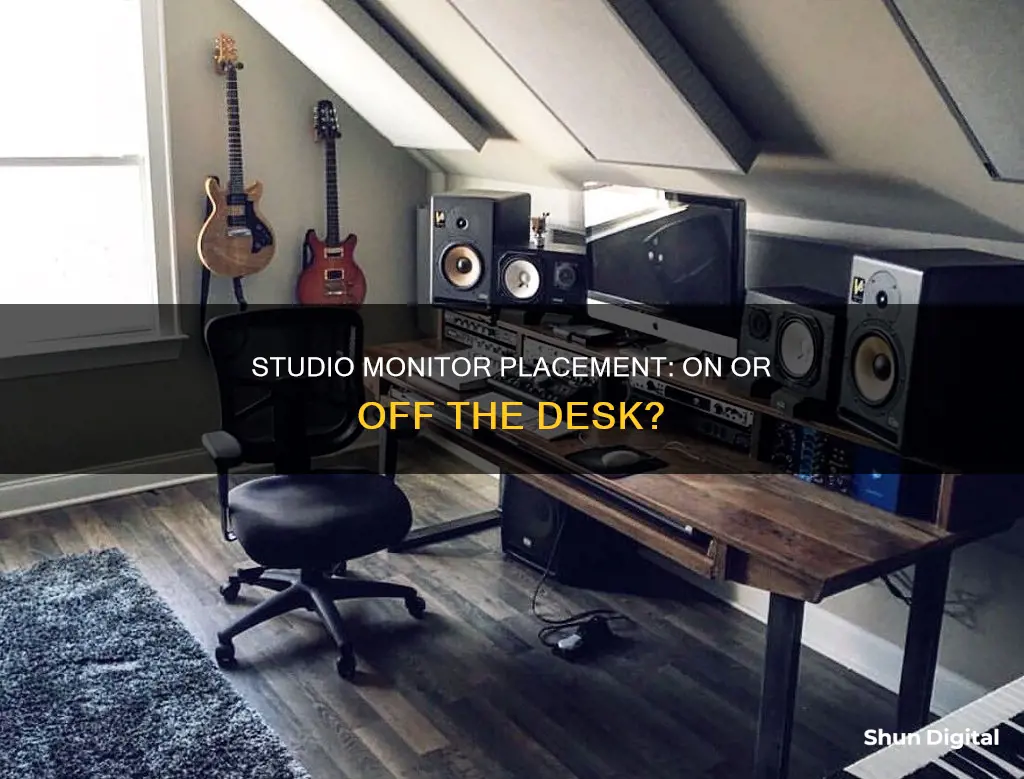
Studio monitors are a crucial component of any recording studio, and their placement is essential for achieving consistent and accurate sound. While it may seem convenient to place them on your desk, there are several factors to consider before making that decision. The ideal setup is to have your monitors and listening position form an equilateral triangle, with the monitors placed at ear level or slightly above, tilted slightly towards your head. Placing monitors on the desk can cause unwanted early reflections and vibrations that interfere with the sound quality. Additionally, the distance from the monitors to the walls and the type of room you're in can impact the frequency response and stereo imaging. Before deciding where to place your studio monitors, it's important to understand the room's acoustics and make adjustments accordingly.
| Characteristics | Values |
|---|---|
| Positioning | The ideal setup is for the listening position and monitor placements to create three points of an equilateral triangle with the monitors turned in to aim towards the ears at approximately a 30-degree angle to the center line. |
| Speaker Placement | Studio monitors sound their best when listened to on-axis, so it is important to ensure the monitors point directly at the listener's head. |
| Speaker Height | Ideally, the tweeters should be at the same height as the listener's ears when seated, typically about 47-55 inches (120-140 cm) from the floor. |
| Speaker Distance from Walls | Monitors should be placed between 5 and 60 cm from walls to avoid the worst opposite waves and sound cancellation. |
| Speaker Isolation | Speakers should be decoupled from the desk surface to avoid unwanted early reflections and vibrations. |
What You'll Learn

Monitors should be placed at ear level or slightly above
When setting up studio monitors, it is important to place them at ear level or slightly above. This is because the directional pattern of sound emanating from the speaker, known as horizontal and vertical dispersion, varies as you move from the front and centre of the speaker. By placing the tweeters at head height, you ensure that your ears are directly in front of the speakers, resulting in the most consistent and optimal sound.
If your desk or console is too low or too high for the speakers to be at ear level, you can adjust the height of the monitors using speaker stands or monitor isolation pads. Speaker stands can be placed on your desk to elevate the monitors, while monitor isolation pads can be used to tilt the speakers slightly upwards, ensuring the sound is directed at your ears.
It is worth noting that the ideal height for studio monitors may vary depending on individual preferences and the specific setup of your studio. Some sources suggest that the tweeters should be at ear level, while others recommend placing the monitors slightly above ear level. Ultimately, the goal is to ensure that the sound is directed accurately towards your ears to achieve the best sound quality.
In addition to height adjustment, it is also crucial to consider the placement of the monitors in relation to the walls and your listening position. Creating an equilateral triangle between the monitors and your listening position, with the monitors pointing directly towards your head, will help create an accurate stereo image and optimise the "sweet spot" for monitoring.
Monitoring Bandwidth Usage by IP on SonicWall
You may want to see also

Avoid placing monitors directly against walls or corners
When placing studio monitors in a room, it is important to consider the room's specific resonant frequencies and how sound will reflect off different surfaces. Every solid surface in a room can act as a boundary that reflects sound to varying degrees, causing phase cancellations and other unwanted acoustic interactions. Therefore, it is recommended to avoid placing monitors directly against walls or corners, as this can create issues in the lower end of the frequency spectrum.
If your monitors are placed close to a wall, the low-frequency energy will travel backward from the cabinet and reflect off the wall. This can cause peaks that reinforce certain frequencies, while others will be cancelled out, creating "troughs". To randomize these peaks and troughs, ensure that the distance from the back of the speaker to the wall behind it is different from the distance between the speaker and the sidewall, as well as the distance to the floor or ceiling.
For nearfield monitors, which perform best up to around 2.5 meters from your listening position, a minimum distance of 20 to 30 cm (8 to 12 inches) between the monitors and walls is recommended. This is generally enough to reduce sound waves reflecting back to your listening position. The maximum distance should be between 60 and 90 cm. It is also important to ensure that the distances between the monitors and the side and back walls are different to avoid creating corners in your listening position.
If your speakers have a rear port, keep them at least 5 to 10 cm away from the wall—the same distance as the diameter of the port. Speakers placed closer than 38 cm or farther than 110 cm from the front wall can result in uneven bass response due to low-frequency reflections. Similarly, try to maintain a distance of at least 110 cm between your speakers and the nearest sidewall. If your speakers must be placed near a sidewall or corner, use the quarter-space EQ setting on the speaker to mitigate any extra bass build-up.
Eliminating Monitor Glare That Affects Glasses: Practical Tips
You may want to see also

Don't place monitors directly on the desk
Placing studio monitors directly on a desk can cause unwanted vibrations and resonances that can interfere with the accuracy of the sound. The desk or stands might vibrate and effectively absorb or amplify certain frequencies. This can result in inconsistencies in the sound and affect your ability to make precise mixing and mastering decisions.
Additionally, placing monitors directly on the desk can cause unwanted early reflections from the desktop surface, which can impact the stereo imaging and the overall sound quality. These reflections can cause what is known as "comb filtering", where the direct sound from the speaker combines with the reflected sound, altering the original audio signal.
To avoid these issues, it is recommended to use speaker isolation pads or stands to decouple the speakers from the desk surface. Isolation pads made of dense foam or multi-layer isolators can help mitigate vibrations and resonances by absorbing them before they transfer to the furniture. Speaker stands also provide height adjustment options and allow for better fine-tuning of the speaker positioning.
Another reason to avoid placing monitors directly on the desk is to achieve the optimal listening position and stereo imaging. By placing the monitors on stands or isolation pads, you can position them at ear level or slightly above, ensuring the sound is directed accurately towards your ears. This helps to reduce unwanted reflections from other surfaces and provides a more consistent and accurate listening experience.
In summary, placing studio monitors directly on a desk can result in unwanted vibrations, early reflections, and suboptimal sound projection. By using isolation pads or stands, you can minimize these issues and improve the overall accuracy and quality of the sound.
Removing Gas Monitor Covers: A Step-by-Step Guide
You may want to see also

Achieve an equilateral triangle setup
Achieving an equilateral triangle setup with your studio monitors is a great way to optimise your listening position and get the best sound. An equilateral triangle setup means that the distance between the left and right speakers is the same as the distance from each speaker to the back of your head. This setup is a good starting point and works for most rooms, but it is not a strict rule.
To achieve this setup, you can use a tape measure, a piece of string, or a guitar cable to ensure that the distances are equal. The ideal distance between the speakers is about 67.5 inches (171.5 cm), but this may vary depending on the size of your room and your speakers. The height of the speakers should be adjusted so that the tweeters are at the same height as your ears when you are seated, typically about 47-55 inches (120-140 cm) from the floor.
If you have a small desk, consider using speaker stands to position the speakers at the correct height and create the optimum geometry. If your room forces you to sit closer to the front wall, you can move the monitors closer together to achieve an equilateral triangle. Conversely, if your speakers are physically large, you may need to increase the size of the triangle.
It is important to note that the equilateral triangle setup is not always possible or optimal, especially if you have a dual-screen setup on your desk. In such cases, you may need to adjust the position of your screens or use speaker stands to create the desired triangle. Additionally, the angle of the speakers can be adjusted slightly to optimise the sound, as long as the distance between the speakers and your ears remains equal.
In-Ear Monitors: Choosing the Right Fit for You
You may want to see also

Avoid console or desk reflections
Reflections from a desk or console can negatively impact the accuracy of your monitoring. If you must place your studio monitors on your desk, place them as close to the front edge as possible and on foam blocks to minimise coupling with the desk. You can also use rubber feet or tacky material to prevent the monitors from moving due to vibration.
However, the ideal setup for correct stereo imaging is to place the monitors behind the desk on secure, decoupled stands. This will help avoid unwanted early reflections caused by the desktop and prevent one monitor's vibrations from affecting the other.
If you are experiencing reflections from your desk, you can try to mitigate them by angling the desktop surface to aim the reflections away from your ears or by placing some sort of absorber at the reflection points on the desk. For example, a broadband absorber or a piece of basotect.
Ankle Monitors: A Viable Prison Alternative in Certain Cases
You may want to see also
Frequently asked questions
It is not ideal to place studio monitors on your desk. The best option is to place them on stands behind the desk to avoid unwanted early reflections caused by the desktop and prevent one monitor's vibrations from affecting the other. If you have to place them on your desk, place them as close to the front edge as possible and on foam blocks to minimise coupling with the desk.
The ideal listening position is where you form an equilateral triangle with your monitors. This means that the distance between the left and right speakers and the distance from each speaker to the back of your head should be equal. This helps create an accurate stereo image and a natural "sweet spot" that lets you move around a bit.
The tweeters of your studio monitors should ideally be at the same height as your ears when you are seated, which is typically about 47-55 inches (120-140 cm) from the floor.
It is recommended to place your studio monitors either almost against the front wall or at least 43 inches (110 cm) away from it. If your speakers are placed close to the wall, their bass response will be exaggerated by up to 6dB. If your speakers have a rear port, keep them at least 5-10 cm away from the wall.







